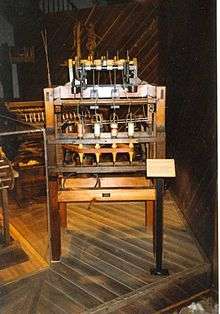Water frame
The water frame is a spinning frame that is powered by a water-wheel. Water frames in general have existed since ancient Egypt times. Richard Arkwright, who patented the technology in 1769,[1] designed a model for the production of cotton thread; this was first used in 1765.[2][3] The Arkwright water frame was able to spin 96 threads at a time, which was an easier and faster method than ever before. The design was partly based on a spinning machine built for Thomas Highs by clock maker John Kay, who was hired by Arkwright.[4] Being run on water power, it produced stronger and harder yarn than the then-famous "spinning jenny", and propelled the adoption of the modern factory system.[5]

Another water-powered frame for the production of textiles was developed in 1760, in the early industrialised town of Elberfeld, Prussia (now in Wuppertal, Germany), by German bleach plant owner Johann Heinrich Bockmühl.[6][7]
The water frame is derived from the use of a water wheel to drive a number of spinning frames. The water wheel provided more power to the spinning frame than human operators, reducing the amount of human labor needed and increasing the spindle count dramatically. However, unlike the spinning jenny, the water frame could spin only one thread at a time until Samuel Compton combined the two inventions into his spinning mule in 1779, which was more effective.
The water frame was originally powered by horses at a factory built by Arkwright and partners in Nottingham. In 1770 Arkwright and partners built a water powered mill in Cromford, Derbyshire.
Cromford
In 1771, Arkwright installed the water frame in his cotton mill at Cromford, Derbyshire, on the River Derwent, creating one of the first factories that was specifically built to house machinery rather than just bringing workers together. It was one of the first instances of the working day being determined by the clock instead of the daylight hours, of people being employed rather than just contracted. In its final form, combined with his carding machine, it was the first factory to use a continuous process from raw material to finished product in a series of operations.[8]
Arkwright played a significant part in the development of the factory system as he combined water power, the water frame, and continuous production with modern employment practices. The water frame played a significant role in the development of the Industrial Revolution.[9]
References
- "Sir Richard Arkwright". Retrieved 2019-03-19.
- John Simkin. "British History - The Textile System - The Water Frame". Spartacus Educational Publishers Ltd., 1997. Retrieved 2019-01-09.
- "A History of the World - Arkwright's Water Frame spinning machine". BBC. Retrieved 2019-01-09.
- McNeil, Ian (1990). An Encyclopedia of the History of Technology. London: Routledge. pp. 827–30. ISBN 0415147921.
- Richard L. Hills, "Hargreaves, Arkwright and Crompton. Why Three Inventors?." Textile history 10.1 (1979): 114-126.
- "Industrial Heritage Expeditions - Textile in Wuppertal". Bergische Struktur- und Wirtschaftsförderungsgesellschaft mbH. Retrieved 2019-01-09.
- Hinrich Heyken. "Von Bleichern, Färbern und Fabrikanten" (PDF). City of Wuppertal. Retrieved 2019-01-09.
- The blast furnace, often considered the first continuous process, was a single process. The water frame, or more specifically the cotton mill of which it was a part, embodied a whole series of processes in one continuity, from raw cotton bale to the spun thread.
- Maxine Berg, The age of manufactures, 1700-1820: Industry, innovation and work in Britain (Routledge, 2005).
External links
| Wikimedia Commons has media related to Water frames. |
- Demonstration of water frame, YouTube
- Cromford Mills World Heritage Site, https://www.cromfordmills.org.uk/
